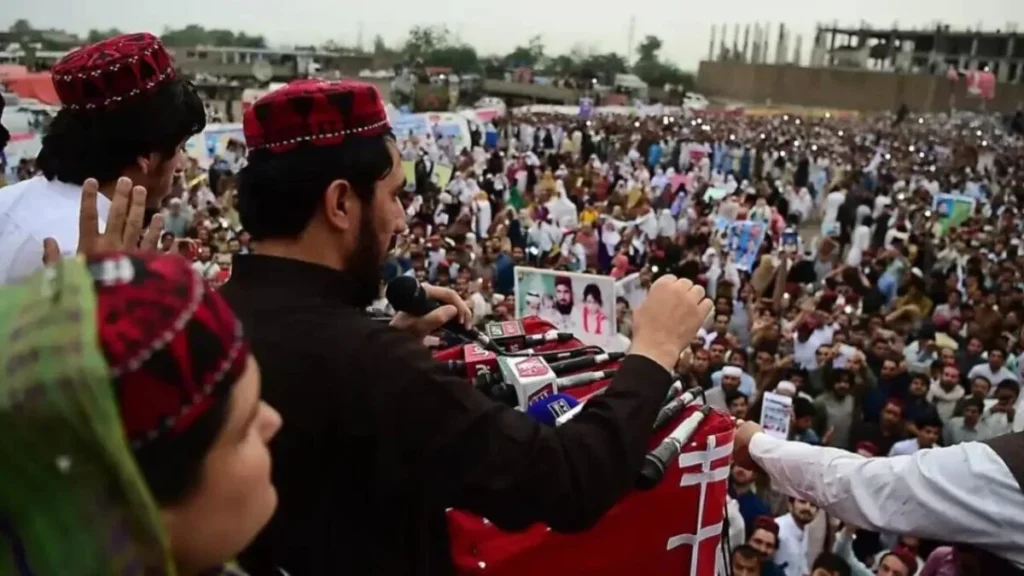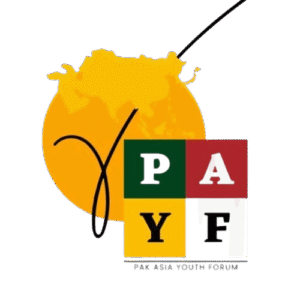The Pashtun Tahafuz Movement (PTM) emerged in 2014 as a grassroots initiative, initially called the Mehsud Tahafuz Movement (MTM), founded by eight students from Gomal University in Dera Ismail Khan. Its primary aim was to highlight human rights abuses and systemic marginalization faced by the Mehsud tribe and broader Pashtun communities, particularly amid Pakistan’s counterterrorism operations in the northwest. The movement gained national prominence following the extrajudicial killing of Naqeebullah Mehsud in January 2018, which catalyzed the “Pashtun Long March” from Dera Ismail Khan to Islamabad and culminated in the “All Pashtun National Jirga,” formally establishing PTM.
Led by Manzoor Pashteen, the movement positioned itself as a champion for justice, the release of missing persons, and the removal of landmines from tribal regions. However, while PTM frames itself as a civil rights platform, careful analysis of its slogans, speeches, and propaganda reveals recurring discursive overlaps with militant narratives that, whether intentional or not, weaken Pakistan’s counterterrorism (CT) credibility and provide ideological material that extremist groups exploit.
PTM Slogans and Rhetorical Patterns
PTM rallies are consistently marked by emotionally charged slogans and recurring narratives portraying state-led counterterrorism operations as attacks on Pashtun communities. Slogans such as “War on Terror = War on Pashtuns” frame military operations as ethnic persecution rather than counterterrorism. Others, including “Zwanan mu qatal kegee” (“Our youngsters are being killed”) and
- Ye jo dashat-gardi hey, esky peechy wardi hey (The uniform [military] is behind this terrorism)
- Ye jo namaloom hey, ye hamen maloom hey (We know all the unknown persons)
- Ye jo talib-gardi hey, esky peechy wardi he (The uniform [military] is behind this Talibanization)
imply state and military complicity in civilian suffering. Leaders like Manzoor Pashteen and Ali Wazir have reinforced these themes in speeches. At a landmark Islamabad jalsa, Pashteen stated: “We are the children of Waziristan who lost our homes and loved ones… every death in the name of terror is the death of a Pashtun youth… For us, the real war is against our own people, not against the terrorists.” Similarly, He also declared that:” those responsible for terrorism are the ones in [military] uniform. These statements draw a false equivalence between militant violence and state CT operations, which TTP and other extremist groups later recycle to reinforce anti-state sentiment.
Overlaps with Militant Messaging
The PTM’s rhetoric often mirrors and amplifies militant messaging. For example, the slogan Lar aw Bar closely resembles the language used by TTP to justify cross-border attacks and delegitimize Pakistan’s sovereignty. Posters, placards, and social media graphics depicting destroyed homes or displaced Pashtun families with captions such as “Pashtuns reject state terrorism” further reinforce the narrative that Pakistan’s security forces are oppressors.
Policy analyses suggest these overlaps are not necessarily due to collusion but emerge when community grievances are not systematically countered by state narratives, leaving a vacuum that militants exploit to position themselves as community defenders. Academic research notes that PTM’s mass-circulated messages of collective victimhood closely echo TTP’s framing, enabling militants to co-opt civil rights rhetoric for recruitment and ideological gain.
Regional and Political Dimensions
Regional dynamics further complicate the issue. TTP leadership continues to find sanctuary across the Afghan border, from where they coordinate attacks inside Pakistan. UN reports estimate 6,000–6,500 fighters in these border areas as of 2024, using ideological narratives advanced by movements like PTM to reinforce their own propaganda. Cross-border attacks targeting infrastructure, civilians, and security personnel feed into the portrayal of CT operations as oppressive, narratives that PTM inadvertently echoes. It is important to note that Afghanistan as a state is not the subject of critique; rather, these territorial realities create operational opportunities for militants that Pakistan must strategically address.
Political actors, particularly PTI leaders, have also contributed to the overlapping narrative environment. Public calls for negotiations with militants, notably after the Taliban takeover of Afghanistan in 2021, have been interpreted by extremists as signaling legitimacy, compounding the ideological space in which PTM rhetoric operates. Pashteen, in an interview, said: “Even Ex Prime Minister Imran Khan once said that our military generals were involved in promoting these (militant) activities”. The Baloch Yakjehti Committee similarly frames state policy as systematic oppression. When these narratives are amplified together in national and international forums, they collectively erode Pakistan’s CT credibility by conflating legitimate security operations with ethnic persecution.
Counterstrategies and Policy Implications
At the same time, mainstream Pashtun civil society and tribal elders have consistently rejected extremist-aligned PTM rhetoric, reaffirm loyalty to Pakistan, and counter attempts to claim sole ownership of the Pashtun identity. Repeated media reports alleging PTM influence by foreign actors further underscore the need to distinguish genuine grievances from narratives that can be exploited by militants.
Pakistan’s counterterrorism strategy must therefore be multi-dimensional. Counter-discursive strategies should acknowledge historical grievances while preventing them from undermining national security. Engagement with local communities is critical for building trust and mitigating militant co-option. Closing regional security gaps through diplomacy and operational coordination is essential, as is developing evidence-based counter-narratives that differentiate civil rights advocacy from extremist propaganda. Analytical platforms can play a pivotal role by mapping these overlaps, demonstrating how PTM rhetoric, militant messaging, and political discourse intersect to weaken CT credibility, and providing policymakers with actionable insights.
Conclusion
While PTM’s emergence reflects genuine grievances of Pashtun communities, its rhetoric demonstrates clear discursive overlaps with militant narratives that compromise Pakistan’s counterterrorism efforts. Addressing these overlaps, strengthening regional and internal security, and fostering credible channels for civil advocacy are essential to ensuring that civil rights movements do not inadvertently empower anti-state actors, thereby safeguarding Pakistan’s CT objectives and national stability.


